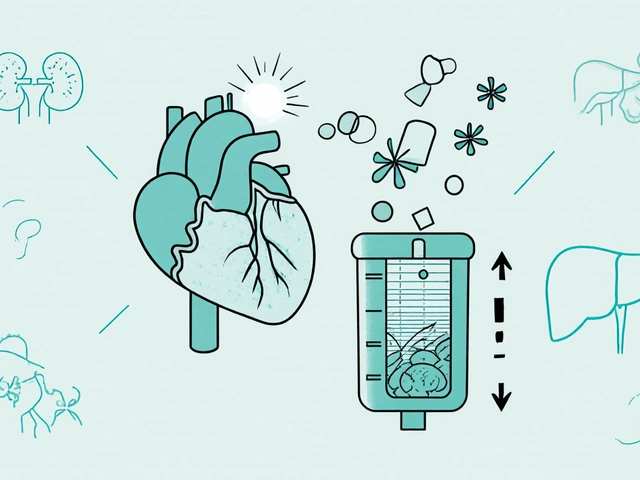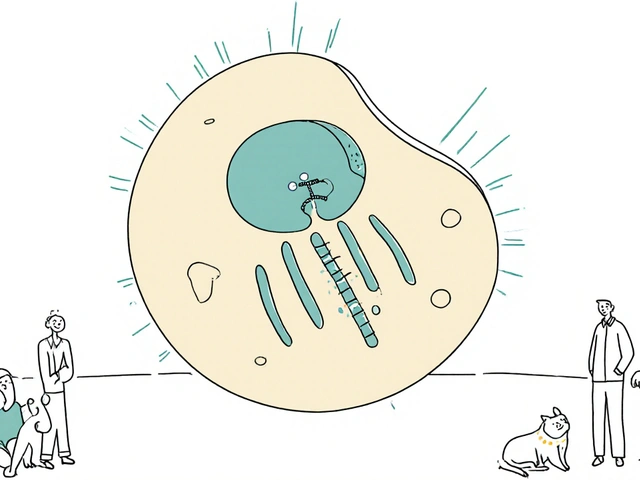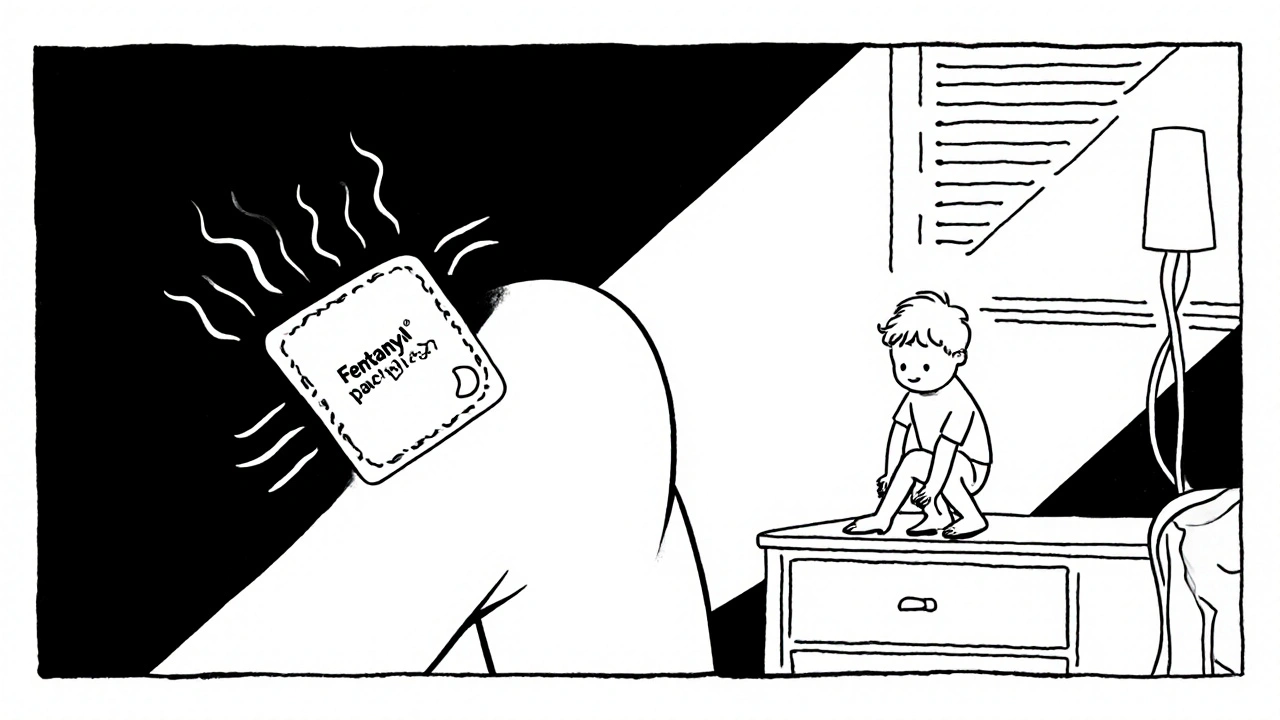
Fentanyl Patch Heat Exposure Risk Calculator
Risk Assessment Tool
Fentanyl patches deliver medication through your skin. When your skin temperature increases, your body absorbs more fentanyl, raising the risk of overdose. This tool calculates how much your absorption rate may increase based on your current skin temperature.
Risk Assessment
Current Absorption
Risk Level
Normal Range
Safety Recommendations
Fentanyl patches are one of the strongest pain medications available. They’re meant for people with severe, long-term pain-like cancer or advanced arthritis-who haven’t found relief with other treatments. But because fentanyl is 50 to 100 times more potent than morphine, even a small mistake can be deadly. The risks aren’t just theoretical. Between 1997 and 2012, 32 children died after accidentally coming into contact with a used or unused patch. And every year, adults die from overdoses caused by heat, improper use, or sudden stopping.
How Fentanyl Patches Work (And Why They’re Dangerous)
Fentanyl patches stick to your skin and slowly release the drug over 72 hours. Unlike pills, which spike and drop in your bloodstream, patches give steady pain relief. That’s good for managing chronic pain-but dangerous if your body isn’t used to it.
The patch doesn’t work right away. It takes 12 to 24 hours to reach full strength. That’s why doctors never prescribe them for sudden pain, after surgery, or for people who haven’t been on opioids before. If you’re opioid-naive and use one, even a low-dose patch can shut down your breathing. That’s because your body has no tolerance. Fentanyl doesn’t care how big you are or how healthy you are. It hits your brain’s breathing control center hard.
Heat makes it worse. A fever, a hot bath, a heating pad, or even sitting in the sun can cause your body to absorb the drug faster. One study found that skin temperature rising just 10°C can double fentanyl absorption. That’s why patients are told: no saunas, no hot tubs, no tanning beds while using these patches.
Overdose: The Silent Killer
An overdose from a fentanyl patch doesn’t look like a movie scene. There’s no screaming or falling over. It’s quiet. Slow. Deadly.
Signs include:
- Slow, shallow, or stopped breathing
- Cold, clammy, or blue skin
- Pinpoint pupils
- Unresponsiveness-no reaction to shaking or shouting
- Extreme drowsiness or inability to wake up
- Slow heartbeat or limp muscles
If someone shows these signs, remove the patch immediately. Call 911. Give naloxone (Narcan) if you have it. Naloxone reverses opioid overdoses, but because fentanyl is so strong, you might need more than one dose. Emergency responders often give multiple vials.
Accidental exposure is a real danger. Kids have opened patches like candy. Adults have touched used patches and then rubbed their eyes. The FDA warns: even a patch that’s been worn for 72 hours still holds up to 80% of its original fentanyl. That’s enough to kill a child.
That’s why disposal matters. Fold the sticky side of the used patch onto itself before throwing it away. Keep patches locked up. Never leave them on a nightstand or in a purse.
Withdrawal: When Stopping Becomes a Crisis
People who use fentanyl patches for weeks or months become physically dependent. That doesn’t mean addiction. It means their body adapted. If you stop suddenly, your body goes into shock.
Withdrawal symptoms start 8 to 24 hours after the last patch is removed. They peak around day 3 and can last up to 10 days-or longer if you were on a high dose for a long time.
Symptoms include:
- Severe anxiety and agitation
- Insomnia and restlessness
- Profuse sweating and chills
- Runny nose and watery eyes
- Stomach cramps, vomiting, diarrhea
- Muscle aches and tremors
- Rapid heartbeat and high blood pressure
- Thoughts of suicide
The FDA issued a safety alert in 2019 after reviewing 148 cases where people suffered seizures, heart attacks, or died after stopping fentanyl abruptly. One patient, a 68-year-old man on a 100 mcg/hour patch for three years, stopped cold after his doctor retired. He developed severe vomiting, dehydration, and heart failure. He didn’t survive.
Withdrawal isn’t usually fatal on its own-but it can lead to life-threatening complications. Vomiting and diarrhea can cause dangerous electrolyte imbalances. Dehydration can trigger kidney failure. Anxiety and depression can lead to self-harm.
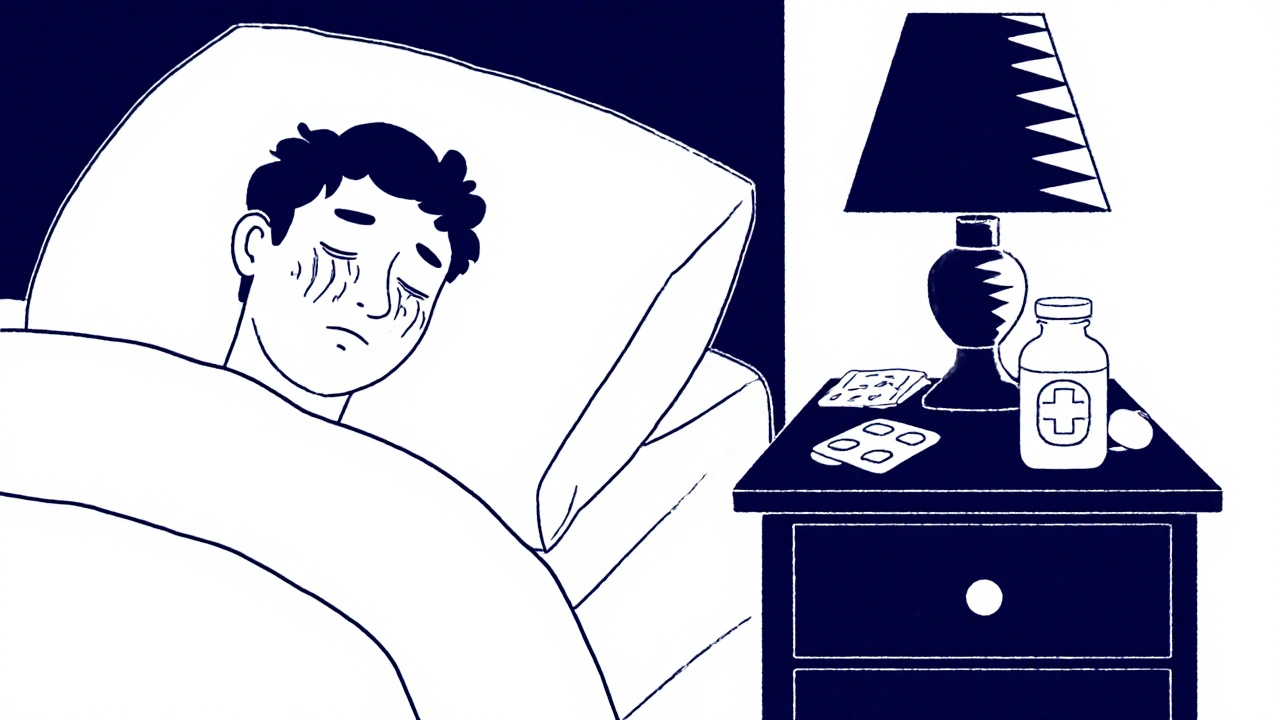
How to Stop Safely
The only safe way to stop fentanyl patches is to taper slowly under medical supervision.
Doctors typically reduce the dose by 10% to 25% every 1 to 3 weeks. If you’re on a high dose-say, 75 mcg/hour or more-it might take months to come off. Rushing it increases the risk of relapse, overdose, or severe withdrawal.
Never adjust your dose yourself. Don’t skip patches. Don’t cut them. Don’t try to “detox” at home. The American Society of Addiction Medicine says detoxing without medical help can leave you dehydrated, confused, or in cardiac arrest.
Your doctor should give you a clear plan. That includes:
- A step-by-step taper schedule
- Medications to ease symptoms (like clonidine for anxiety or anti-nausea drugs)
- Regular check-ins to monitor your health
- Naloxone on hand in case of accidental overdose during tapering
Since 2023, the FDA recommends that all patients prescribed fentanyl patches also get a prescription for naloxone. It’s not optional. It’s a safety net.
What You Must Do If You’re Using Fentanyl Patches
If you or someone you love is on a fentanyl patch, here’s what you need to do right now:
- Never use heat. No heating pads, no hot tubs, no fever without calling your doctor.
- Store patches safely. Keep them locked away, out of reach of kids, pets, or visitors.
- Dispose of used patches properly. Fold sticky side to sticky side. Throw in household trash-not recycling.
- Carry naloxone. If you don’t have it, ask your pharmacist. Learn how to use it.
- Never stop suddenly. Talk to your doctor before changing your dose-even by one patch.
- Tell every doctor you see. Even dentists. Fentanyl can interact with anesthesia and other drugs.
- Don’t share. Even one patch can kill someone who’s not tolerant.
Prescriptions for fentanyl patches have dropped 42% since 2016. That’s because doctors now know the risks. They only prescribe them when other options have failed. If your doctor is pushing you to start one, ask: “Have I tried everything else?”
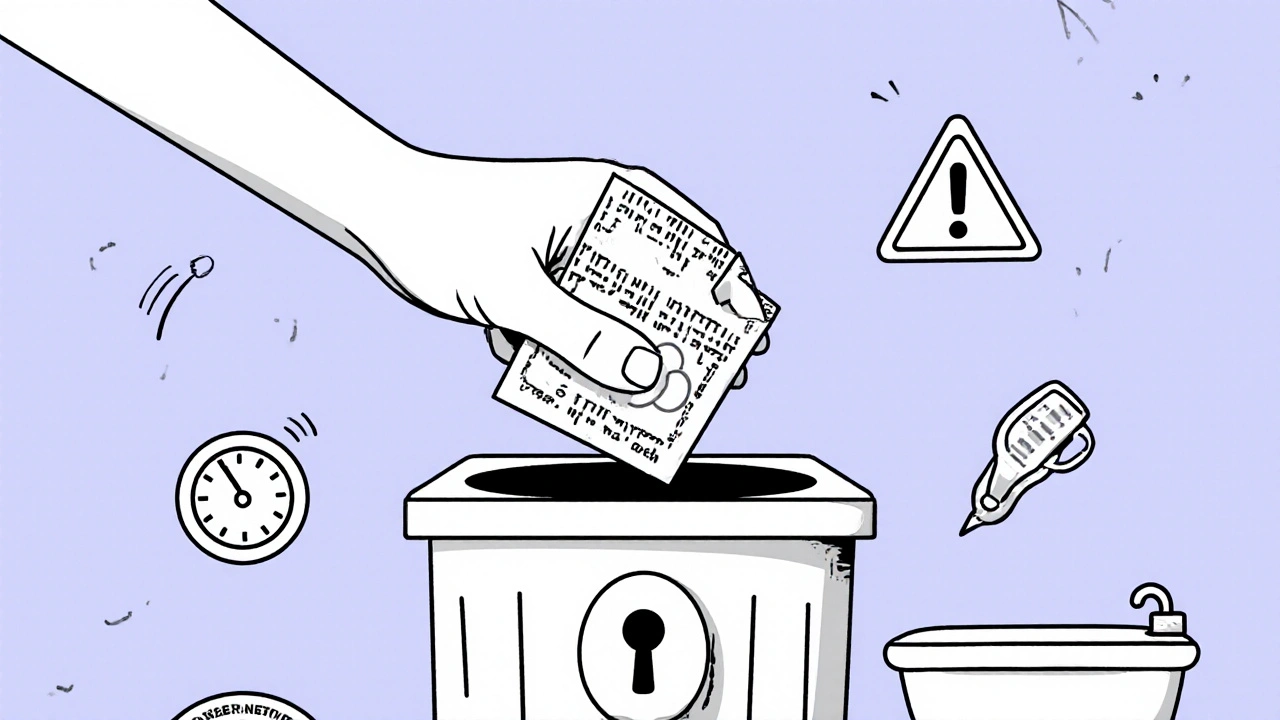
What’s Changing in 2025?
Researchers are working on safer patches. Two clinical trials are testing new designs that reduce accidental exposure-like patches that only release drug if the skin is at normal temperature, or ones that deactivate after 72 hours even if not removed.
The FDA’s REMS program now requires doctors to complete training before prescribing. That’s helped. Since 2012, the rate of appropriate tapering has increased by 35%. But many patients still fall through the cracks-especially in rural areas or without regular care.
One thing hasn’t changed: fentanyl patches are not for everyone. They’re a last-resort tool for a very specific group of patients. For most people with chronic pain, physical therapy, nerve blocks, or non-opioid meds are safer and just as effective.
If you’re on a fentanyl patch, you’re not alone. But you’re in a high-risk group. Treat this medication with the respect it demands. One mistake can end a life. But with the right knowledge and care, you can manage your pain-and stay alive.
Can you overdose from a fentanyl patch even if you’ve been using it for months?
Yes. Even if you’ve been using a fentanyl patch for months, you can still overdose if your body’s tolerance drops or if you’re exposed to heat. Fever, hot baths, or even wearing extra layers can cause your skin to absorb the drug faster than normal. Also, if you miss doses and then take your usual patch, your tolerance may have decreased, putting you at risk. Always follow your doctor’s instructions and avoid anything that raises your body temperature.
How long does fentanyl withdrawal last?
Withdrawal symptoms usually start 8 to 24 hours after the last patch is removed. They peak between 36 and 72 hours and typically last 7 to 10 days. But for people on high doses for a long time, symptoms like anxiety, insomnia, and muscle aches can linger for weeks. Tapering slowly reduces the severity and length of withdrawal. Stopping cold turkey makes it worse and more dangerous.
Is it safe to cut a fentanyl patch to lower the dose?
No. Never cut, chew, or alter a fentanyl patch. The drug is stored in a gel layer, and cutting it can cause the entire dose to be released at once. This can lead to a fatal overdose within minutes. Dose changes must be made by switching to a different strength patch under medical supervision. There are no safe ways to split a patch.
Can you use fentanyl patches with other pain medications?
Fentanyl patches should not be combined with other opioids, benzodiazepines, sleep aids, or alcohol. These drugs all depress the central nervous system. When mixed with fentanyl, they dramatically increase the risk of respiratory failure and death. Even over-the-counter sleep aids or muscle relaxants can be dangerous. Always tell your doctor about every medication you take, including supplements.
What should I do if a child or pet touches a used fentanyl patch?
Remove the patch immediately and wash the skin with plain water. Call poison control or 911 right away. Even a small amount of fentanyl from a used patch can be fatal to a child or pet. Do not wait for symptoms to appear. Time is critical. Keep patches locked up and out of reach at all times.
Do I need naloxone if I’m on a fentanyl patch?
Yes. The FDA now recommends that everyone prescribed a fentanyl patch also get naloxone. It’s a life-saving medication that can reverse an overdose. Keep it where you can find it quickly-like by your bed or in your wallet. Make sure someone close to you knows how to use it. Naloxone is not a substitute for emergency care-always call 911 after giving it.
Can fentanyl patches cause addiction?
Physical dependence is common with long-term use, but addiction is different. Addiction means you keep using the drug despite harm, cravings, or loss of control. Most people on fentanyl patches for chronic pain do not become addicted. But if you find yourself taking extra patches, hiding use, or feeling anxious when you run low, talk to your doctor. Addiction can develop, especially if you have a history of substance use disorder.
What to Do Next
If you’re on a fentanyl patch, schedule a check-up with your doctor. Ask: “Is this still the best option for me?” Many people stay on them longer than needed because they’re afraid to stop. But there are alternatives-nerve blocks, spinal cord stimulators, physical therapy, or non-opioid medications like gabapentin or duloxetine.
If you’re worried about withdrawal, don’t wait until you run out. Talk to your doctor now. Get a taper plan. Get naloxone. Educate your family.
Fentanyl patches save lives when used correctly. But they can end them just as fast if used carelessly. Knowledge isn’t just power-it’s protection.

